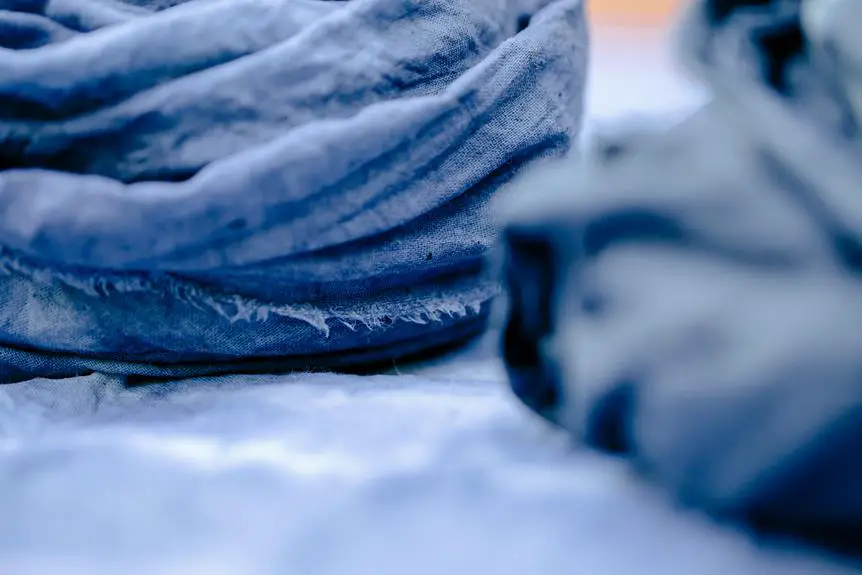When you're looking to dye ponte fabric, understanding its unique properties is crucial. You'll need to choose a dye that's compatible with the fabric's composition, especially if it's a polyester blend. Prepping the fabric properly can make a significant difference in how well the dye adheres, so don't skip that step. Once you're ready, you might find yourself at a crossroads on which dyeing technique to use. The choice you make here can influence the final look dramatically—so what will you go for?
Table of Contents
Understanding Ponte Fabric
Ponte fabric is a stretchy, double-knit material known for its versatility and comfort, making it a popular choice for clothing like dresses and pants.
You'll find ponte fabric typically made from a blend of rayon, polyester, and spandex, which gives it that soft feel and a bit of elasticity. This fabric's structure allows it to hold its shape well, resisting wrinkles and sagging, so it's perfect for both everyday wear and more structured garments.
One of the standout features of ponte is its weight. It's heavier than many other knits, providing excellent coverage without being overly thick. This quality makes it a great option for transitional seasons, as it drapes nicely and can be layered.
When working with ponte, keep in mind that its stretch can affect how it reacts to dyes, so you'll want to consider this when planning your dyeing project.
Lastly, ponte fabric's durability means it can withstand regular wear while maintaining a polished appearance, making it a staple in many wardrobes. Understanding these characteristics will help you choose the right approach when you're ready to dye your ponte fabric.
Choosing the Right Dye
When selecting a dye for ponte fabric, consider the material composition and how it will interact with different dye types. Ponte fabric typically contains a blend of polyester and spandex, which means you'll want a dye that effectively bonds to synthetic fibers. For this, look for disperse dyes, specifically formulated for polyester. These dyes penetrate the fibers and provide vibrant, long-lasting colors.
If your ponte fabric has a significant cotton component, you could use fiber reactive dyes, as they work well with natural fibers. However, remember that using the wrong dye could lead to uneven coloring or fading after washing.
Before making a final choice, check the dye manufacturer's instructions. Some dyes require specific temperatures or methods, like immersion dyeing or spray application, to achieve the best results.
It's also important to consider the colorfastness of the dye, especially if you plan to wash the fabric frequently.
Preparing the Fabric
Before you start dyeing your ponte fabric, it's crucial to prepare it properly.
You'll want to pre-wash the fabric to remove any finishes that could affect the dye absorption.
Additionally, setting up a clean workspace will help ensure a smooth and successful dyeing process.
Choosing the Right Dye
How do you ensure you select the best dye for your ponte fabric? The key is to understand the fiber content of your fabric and choose a dye that works with it. Ponte is typically made from a blend of polyester and rayon, so you'll want to select a dye suitable for synthetic fibers. Here's a quick guide to help you choose the right dye:
| Dye Type | Best For |
|---|---|
| Fiber Reactive | Natural fibers (not ideal) |
| All-Purpose Dye | Blends of natural and synthetic fibers |
| Polyester Dye | Specifically for synthetic fibers |
When you pick your dye, consider whether you want a solid color or a more nuanced result. If you're aiming for vibrant hues, polyester dye is your best bet. Always check the manufacturer's instructions for dyeing techniques and recommended fabrics. Finally, don't forget to test a small sample of your fabric with the dye to see how the color turns out. This ensures you achieve the desired shade without any surprises!
Pre-Washing the Fabric
Pre-washing your ponte fabric is essential to remove any chemicals or finishes that could interfere with the dyeing process. When you buy ponte fabric, it often comes treated with sizing or other substances that can prevent the dye from adhering properly. To ensure you get even and vibrant color, you need to wash the fabric first.
Start by filling a sink or tub with warm water. Add a mild detergent, making sure it's suitable for fabrics. Submerge the ponte fabric completely, gently agitating it to help release any residues. Avoid using hot water, as it can cause the fabric to shrink or lose its elasticity.
After about 10 to 15 minutes, rinse the fabric thoroughly in cool water until the water runs clear. Once rinsed, lay the fabric flat on a clean towel to remove excess water, then hang it to dry completely. Avoid using a dryer, as heat can again alter the fabric's properties.
After pre-washing, your ponte fabric will be ready for dyeing, ensuring that your finished project turns out as vibrant and beautiful as you envision.
Setting Up Workspace
Creating a clean and organized workspace is crucial for successfully dyeing your ponte fabric. Start by gathering all necessary supplies and laying them out in a way that's easy to access. You'll want to ensure you have sufficient lighting to see the colors accurately as you work.
Next, protect your surfaces. Cover your work area with plastic sheeting or old towels to prevent any dye stains. Make sure you're wearing old clothes or an apron, too, since dye can splatter.
Here's a quick checklist to help you prepare your workspace:
| Item | Purpose |
|---|---|
| Plastic sheeting | Protect surfaces from stains |
| Old towels | Absorb spills and drips |
| Dyeing tools | Apply and mix colors |
| Gloves | Protect your hands |
With everything arranged and protected, you're ready to move on to mixing your dye. Having a well-prepared workspace not only streamlines the process but also helps you focus on achieving the best results for your ponte fabric dyeing project. Happy dyeing!
Dyeing Techniques
When dyeing ponte fabric, you'll find that selecting the right technique can make all the difference in achieving vibrant and lasting colors.
One popular method is immersion dyeing, where you submerge the fabric in a dye bath. This technique allows for even coverage and is great for achieving deep hues. Make sure to pre-wash your fabric to remove any finishes that may affect dye absorption.
Another effective technique is tie-dyeing. By folding, twisting, or binding the fabric, you can create unique patterns and color variations. This method is excellent for those who want a more artistic look.
For a more controlled approach, consider using a spray or sponge application. This allows you to apply dye precisely and can yield beautiful gradients.
If you're looking for a quick solution, fabric markers or dye pens can be used for detailed designs or touch-ups. Just remember, they're best for smaller areas.
Whichever technique you choose, always test a small fabric swatch first to see how the dye interacts with your ponte. This way, you'll better understand how the final product will look.
Get creative and enjoy the process!
Setting the Color
Once you've dyed your ponte fabric, it's crucial to set the color properly.
Start by prepping the fabric to ensure even results, then choose the right dye to lock in that vibrant hue.
These steps will help prevent fading and keep your fabric looking fresh.
Prepping the Fabric
To effectively set the color in your ponte fabric, you'll often want to wash it first to remove any finishes that might interfere with dye absorption. Start by checking the care label to determine the best washing method. Use a gentle cycle with mild detergent to preserve the fabric's quality.
Next, rinse the fabric thoroughly to ensure all detergent is removed. After washing, you can either air dry or tumble dry on low heat, depending on the fabric's care instructions. Once your ponte fabric is clean and dry, it's ready for dyeing.
Here's a quick reference table to help you prep your ponte fabric:
| Step | Action | Purpose |
|---|---|---|
| 1. Wash | Use gentle cycle and mild detergent | Remove finishes for better dye absorption |
| 2. Rinse | Thoroughly rinse the fabric | Ensure no detergent residue remains |
| 3. Dry | Air dry or tumble dry on low heat | Prepare fabric for dyeing |
Following these steps will help you achieve a more vibrant and even dye result. Now, you're all set to choose your dye!
Choosing the Dye
With your ponte fabric prepped and ready, choosing the right dye is key to achieving the color you desire. Ponte fabric is typically made from a blend of polyester and rayon, so you'll want to select a dye that works well with synthetic fibers.
Consider the following factors when making your choice:
- Type of Dye: Acid dyes are great for polyester blends, while fiber-reactive dyes work better on natural fibers. Make sure to choose a dye that specifically states it can be used on synthetic fabrics.
- Color Fastness: Look for dyes known for their durability. Color fastness ensures that your fabric maintains its vibrancy after washing and wearing.
Once you've selected the dye, follow the manufacturer's instructions carefully for the best results. This will help you set the color firmly in your ponte fabric, ensuring it looks great and lasts longer.
Happy dyeing!
Caring for Dyed Ponte
Caring for dyed ponte requires gentle handling and specific washing techniques to maintain its vibrant color and soft texture.
Start by washing your ponte fabric in cold water using a mild detergent. Hot water can cause the dye to fade and the fabric to lose its shape. Always turn the garment inside out to protect the exterior from abrasion during washing.
When it comes to drying, avoid using a dryer, as the heat can shrink the fabric and alter its texture. Instead, lay the ponte flat on a clean, dry towel to absorb excess moisture, then reshape it and let it air dry away from direct sunlight to prevent fading.
If you need to iron your dyed ponte, do so on a low heat setting, and use a pressing cloth to avoid direct contact with the fabric. This will help maintain the dye's vibrancy and the fabric's softness.
Lastly, always store your ponte items in a cool, dry place, and avoid hanging them for long periods to prevent stretching. With proper care, your dyed ponte will stay looking fresh and beautiful for a long time.
Creative Project Ideas
Explore exciting ways to transform your dyed ponte fabric into unique fashion pieces and home decor items that showcase your personal style. This versatile fabric can elevate your wardrobe and living space with just a bit of creativity. Here are some project ideas to inspire you:
- Chic Dresses: Use your dyed ponte to create fitted dresses that hug your curves. Experiment with different patterns and colors to make a statement piece for any occasion.
- Stylish Tops: Design trendy tops or blouses that can be paired with jeans or skirts. Consider adding unique necklines or sleeves to give your top a personal touch.
With these ideas, you'll not only make the most of your dyed ponte fabric but also express your creativity.
Frequently Asked Questions
Can I Mix Different Dye Colors for a Custom Shade?
Yes, you can mix different dye colors to create a custom shade. Just experiment with small amounts, and remember that colors can blend unpredictably. Keep track of your ratios for consistent results in future projects!
Is It Safe to Dye Ponte Fabric at Home?
Yes, it's generally safe to dye fabric at home, but you should take precautions. Always wear gloves, work in a well-ventilated area, and follow dye instructions closely to ensure a successful and safe experience.
What Tools Do I Need for Dyeing Ponte Fabric?
For dyeing ponte fabric, you'll need fabric dye, a pot for boiling water, stirring tools, gloves, and a sink or bucket for rinsing. Having a thermometer can help you maintain the right water temperature too.
How Long Will the Dye Last on Ponte Fabric?
The dye's longevity on ponte fabric depends on several factors, like the type of dye used and how well you care for the item. Generally, you can expect vibrant colors to last several washes with proper maintenance.
Can I Dye Ponte Fabric That Has Been Previously Washed?
Yes, you can dye ponte fabric that's been washed. Just ensure the fabric's clean and free of any residues. The dye will adhere better, giving you vibrant results. Enjoy transforming your fabric!
- How Is Moisture-Wicking Different From Simply Being Absorbent? - June 6, 2025
- Understanding Hydrophilic vs. Hydrophobic Fibers in Wicking - June 6, 2025
- What Does “Wicking” Mean in Clothing Terminology? - June 6, 2025







